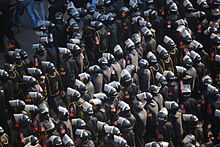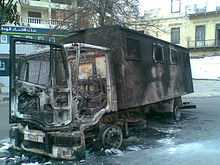Central Security Forces
 Central Security Forces Emblem | ||
|---|---|---|
| Military manpower | ||
| Military age | 18 years of age for conscript military service; 3-year service obligation (2001) | |
| Availability | males age 18–49: 18,347,560 (2005) | |
| Fit for military service | males age 18–49: 15,540,234 (2005) | |
| Reaching military age annually | males: 802,920 (2005) | |
| Active troops | 450,000 (Ranked 11th) | |
| Military expenditures | ||
| Dollar figure | $2.44 billion (2003)+ $1.3 billion of U.S military aid annually | |
| Percent of GDP | 3.4% (2004) | |



The 450,000 strong General Security and Central Security Forces (Arabic: قوات الأمن العام و الأمن المركزي Quwwāt al-Amn al- Amm wa Quwwāt al-Amn al-Markazī, often shortened to الأمن المركزي Al-Amn al-Markazī) CSF organisation is an Egyptian paramilitary force which is responsible for assisting the Egyptian National Police (ENP) for the security of governmental fixed sites, foreign embassies & missions, riots & crowds control, publicly crowded events, high risk arrests, disaster response and SWAT operations. They are a vital arm of Egypt's National Security apparatus.
History
In 1969,[1] a decision was made to create the Central Security Forces from well trained and equipped police forces on large scale covering the whole country under the command of the Ministry of Interior (Egypt) to conduct special police operations in response to operational needs. The creation of those forces followed the paramilitary model, and became close – in formation, training, equipment and operating procedures – to the Italian Carabinieri, Indian CRPF and the Russian OMON. The initial batch of recruits were drawn from the Police and had to undergo military training under the Army. Later on, in 1970, a separate training institute was set up for the CSF and the force started conscripting its recruits, just like regular Army conscripts. The CSF was set up to deal with the growing unrest and public disorder following the Egyptian defeat in the Six day war. The CSF was deployed by the Sadat government to tackle large protests by Leftist and hardline Nasserist groups in January 1972 in Cairo, the protests were called to protest against Sadat's anti-Soviet and anti-Palestinian foreign policy, lack of action against Israel and right-wing economic measures such as cutting some subsidies and increasing some prices of welfare services like public transport. CSF units had to use force to disperse the rioting crowds in Tahrir Square which led to the shooting death of three protestors.
Following the 1973 Arab Israeli War between Egypt and Israel – then settling the 1973 & 1974 Ceasefire agreements; the 1979 Egyptian–Israeli Peace Treaty was signed and the subsequent Israeli withdrawal from the rest of Sinai Peninsula occurred. The Treaty stipulated the Egyptian government refrain from deploying regular Egyptian Armed Forces units in the eastern part of Sinai that directly border Israel (Zone “C”). The Egyptian government then tasked the Central Security Forces to take up the task. The CSF force deployed is effectively a motorised light infantry force without the heavy weapons and equipment.
The Egyptian government subsequently came to rely on the CSF to quell any source of instability within the country and to uphold the emergency laws imposed on Egypt since the 1981 assassination of the President of Egypt, Anwar Sadat. The CSF was especially deployed to tackle armed Islamist insurgents. From the 1990s onwards, CSF has become operationally coordinated with the State Security, meaning CSF units can be ordered to deploy by State Security officers, and has been called the "battering ram of State Security".
Incidents
In 1986, hundreds of third category, low ranking, CSF personnel (soldiers) staged a four-day mutiny, in the Egyptian Conscription Riot. The riot was a reaction to the spread of false rumours among its conscripts that their (three year) conscription time will be extended by a year. The insurrection was suppressed by the Egyptian Army. They rampaged through the suburb of Giza burning some hotels and shops in tourist areas. They also burned dozens of cars and buses. Over 20,000 conscripts were dismissed from service with no benefits, and the agitators received correctional punishment after being tried before State Security Court for arson, violent riots, and insubordination according to penal code. Some reports related that mutiny to a conspiracy against the Minister of Interior in charge by then (Gen. Ahmed Roshdy) due to his policies. After the suppression the government promised to overhaul the force by raising its entry standards, increasing payment and bettering living conditions in their camps.
Organization
The CSF is headed by a Director General, who is a 3-star Police General of the Interior Ministry, and is organised as follows:
- Main Headquarters (MHQ).
- Special Operations Command.
- (6) Specialized Training Institutes.
- (8) AOR Operational Regions – Cairo, Alexandria, Giza, Central & Western Nile Delta, Eastern Nile Delta, Suez Canal & Sinai, Southern Upper Egypt, and Northern Upper Egypt.
Deployment and operating procedures
Similar to other central paramilitary organizations in other countries, CSF deployment is divided into three parts - Baton, Gas, and Armed. The basic unit formation of the CSF is a company which is commanded by a Police Captain (naqib) or in some cases a Major who is a commissioned officer and a graduate of the Police College. A senior Lieutenant (mulazim awwal) (or Captain when the commander is a Major), is usually second-in-command.
A CSF company consists of approximately 150 personnel and is composed of two Baton platoons, a Gas platoon, and an Armed platoon. Each platoon is also commanded by a Lieutenant with a Sergeant (raqib) as second-in-command.
Approximately 3 to 4 companies make up a CSF Battalion, which is commanded by an officer of Lieutenant Colonel or Colonel rank.
The Baton platoons are equipped with batons and shields, the gas platoon is responsible for the deployment of Teargas, and the armed platoon usually carries assault rifles - usually the AK 47 variants. However, under emergency laws and martial law, the non-armed CSF units can be converted into armed units, and they are additionally equipped with LMGs, recoilless rifles and sniper rifles for anti-insurgency operations.
Also, the three-part deployment of CSF is not applicable in regions like the North Sinai, where all units are armed at all times.
Recruitment
The Central Security Forces personnel consists of three categories;
- Commissioned Officers (graduated from the Police College of 4 Academic years), who enter the service with the rank of Lieutenant. They are recruited via national-level exams for Police officers, they receive their commission from the President;
- Sub-officers (graduated from Police School of 2 Academic years), they are equivalent to the Non-commissioned officers of the Army; and
- Conscripts (of 6 months training) recruited entirely from the low educated recruits, as the more educated and college graduates usually end up in the different branches of the regular military service. Conscripts can later be promoted to the ranks of sub-officers if they continue in the service beyond their compulsory terms and if they get a higher education and sit for the mandatory exams for entering sub-officer ranks. There is high competition among conscripts to extend their service and to become regularized troops, this is because of the high rate of unemployment in Egypt. A conscript enters the force as a "Private Recruit" and is promoted to "Private First Class" after 2 years of service. At the time of demobilization/release from compulsory 3 years' service, many who have passed their 10th grade in school, are at the rank of Areef or Corporal and can command a section of 10-12 conscripts and 1 riot vehicle. Less educated or illiterate conscripts, however, have to retire at the rank of Private First Class. Those among the Corporals who wish can sit for exams to extend their service and receive the rank of Deputy Sergeant or Junior Sergeant. Most of the conscripts/NCOs are forced to retire at 52 years of age with the rank of Sergeant with no chance of advancement if they do not have a college degree. Less than 2% of conscripts advance into the commissioned officer ranks.
Ranks
Officers -
- Director General (a Lieutenant General ranking officer)
- Major General (Liwa)
- Brigadier General (Amid)
- Colonel (Aqid)
- Lieutenant Colonel (Moqaddem)
- Major (Raed)
- Captain (Naqib)
- First Lieutenant (Mulazim Awal)
- Lieutenant (Mulazim)
Sub-officers-
- Sergeant First Class (Raqib awwal) - this rank is held only by the two or three senior-most NCOs in a Battalion.
- Sergeant (Raqib)
- Deputy Sergeant/Junior Sergeant (Raqib Musaaed) - first NCO rank
- Corporal (Areef) - after 3 years of compulsory service, it is usually held by Section/Troop leaders.
Conscripts -
- Private First Class/Junior Corporal/Squad Leader (Musaed areef)
- Private Recruit/Conscript (Mujannad)
See also
References
- ↑ "A Country Study: Egypt". Library of Congress. Retrieved 1 November 2011.
External links
- Paramilitary forces at ORBAT.com
- Egyptian Armed Forces
- CSF at Egypt Country Study
- CIA World Factbook
- FAS
- GlobalSecurity
| ||||||||||||||
| ||||||||||||||